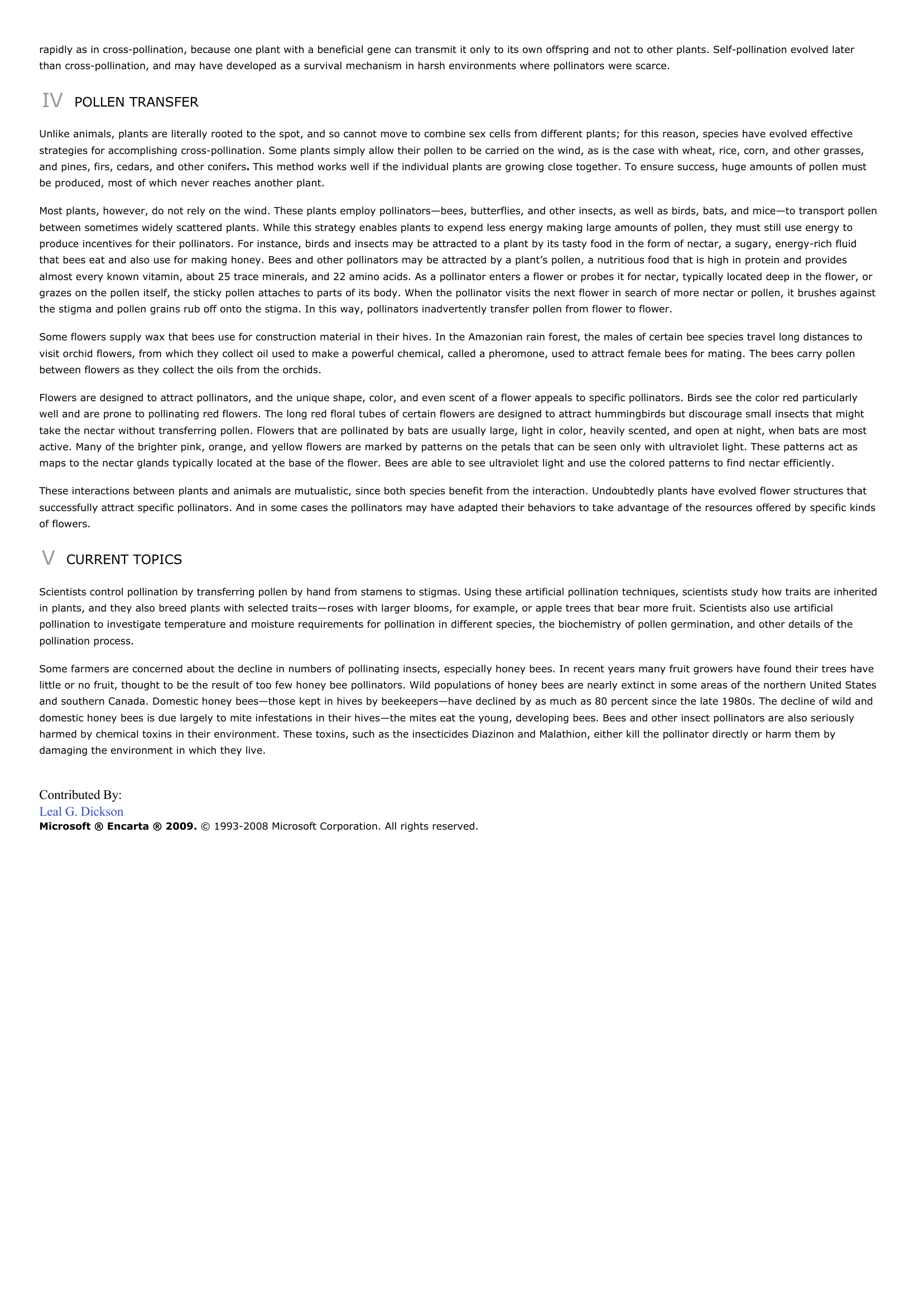Pollination - biology.
Publié le 11/05/2013
Extrait du document
«
rapidly as in cross-pollination, because one plant with a beneficial gene can transmit it only to its own offspring and not to other plants.
Self-pollination evolved laterthan cross-pollination, and may have developed as a survival mechanism in harsh environments where pollinators were scarce.
IV POLLEN TRANSFER
Unlike animals, plants are literally rooted to the spot, and so cannot move to combine sex cells from different plants; for this reason, species have evolved effectivestrategies for accomplishing cross-pollination.
Some plants simply allow their pollen to be carried on the wind, as is the case with wheat, rice, corn, and other grasses,and pines, firs, cedars, and other conifers .
This method works well if the individual plants are growing close together.
To ensure success, huge amounts of pollen must be produced, most of which never reaches another plant.
Most plants, however, do not rely on the wind.
These plants employ pollinators—bees, butterflies, and other insects, as well as birds, bats, and mice—to transport pollenbetween sometimes widely scattered plants.
While this strategy enables plants to expend less energy making large amounts of pollen, they must still use energy toproduce incentives for their pollinators.
For instance, birds and insects may be attracted to a plant by its tasty food in the form of nectar, a sugary, energy-rich fluidthat bees eat and also use for making honey.
Bees and other pollinators may be attracted by a plant’s pollen, a nutritious food that is high in protein and providesalmost every known vitamin, about 25 trace minerals, and 22 amino acids.
As a pollinator enters a flower or probes it for nectar, typically located deep in the flower, orgrazes on the pollen itself, the sticky pollen attaches to parts of its body.
When the pollinator visits the next flower in search of more nectar or pollen, it brushes againstthe stigma and pollen grains rub off onto the stigma.
In this way, pollinators inadvertently transfer pollen from flower to flower.
Some flowers supply wax that bees use for construction material in their hives.
In the Amazonian rain forest, the males of certain bee species travel long distances tovisit orchid flowers, from which they collect oil used to make a powerful chemical, called a pheromone, used to attract female bees for mating.
The bees carry pollenbetween flowers as they collect the oils from the orchids.
Flowers are designed to attract pollinators, and the unique shape, color, and even scent of a flower appeals to specific pollinators.
Birds see the color red particularlywell and are prone to pollinating red flowers.
The long red floral tubes of certain flowers are designed to attract hummingbirds but discourage small insects that mighttake the nectar without transferring pollen.
Flowers that are pollinated by bats are usually large, light in color, heavily scented, and open at night, when bats are mostactive.
Many of the brighter pink, orange, and yellow flowers are marked by patterns on the petals that can be seen only with ultraviolet light.
These patterns act asmaps to the nectar glands typically located at the base of the flower.
Bees are able to see ultraviolet light and use the colored patterns to find nectar efficiently.
These interactions between plants and animals are mutualistic, since both species benefit from the interaction.
Undoubtedly plants have evolved flower structures thatsuccessfully attract specific pollinators.
And in some cases the pollinators may have adapted their behaviors to take advantage of the resources offered by specific kindsof flowers.
V CURRENT TOPICS
Scientists control pollination by transferring pollen by hand from stamens to stigmas.
Using these artificial pollination techniques, scientists study how traits are inheritedin plants, and they also breed plants with selected traits—roses with larger blooms, for example, or apple trees that bear more fruit.
Scientists also use artificialpollination to investigate temperature and moisture requirements for pollination in different species, the biochemistry of pollen germination, and other details of thepollination process.
Some farmers are concerned about the decline in numbers of pollinating insects, especially honey bees.
In recent years many fruit growers have found their trees havelittle or no fruit, thought to be the result of too few honey bee pollinators.
Wild populations of honey bees are nearly extinct in some areas of the northern United Statesand southern Canada.
Domestic honey bees—those kept in hives by beekeepers—have declined by as much as 80 percent since the late 1980s.
The decline of wild anddomestic honey bees is due largely to mite infestations in their hives—the mites eat the young, developing bees.
Bees and other insect pollinators are also seriouslyharmed by chemical toxins in their environment.
These toxins, such as the insecticides Diazinon and Malathion, either kill the pollinator directly or harm them bydamaging the environment in which they live.
Contributed By:Leal G.
DicksonMicrosoft ® Encarta ® 2009. © 1993-2008 Microsoft Corporation.
All rights reserved..
»
↓↓↓ APERÇU DU DOCUMENT ↓↓↓
Liens utiles
- Alligator - biology.
- Amphibian (animal) - biology.
- Basilisk - biology.
- Boa - biology.
- Caecilian - biology.







